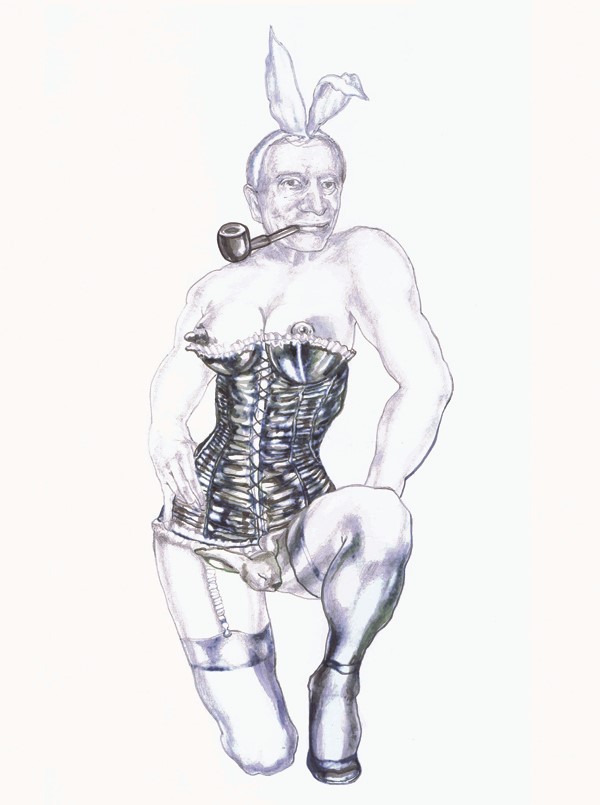British feminist artist Margaret Harrison made headlines in 1971 when her first solo exhibition was raided and shut down by police on grounds of indecency. Forty years later, Harrison will display original images from the exhibition alongside new
British feminist artist Margaret Harrison made headlines in 1971 when her first solo exhibition was raided and shut down by police on grounds of indecency. Forty years later, Harrison will display original images from the exhibition alongside new works at London’s PayneShurvell. I Am Fantasy unites the feminist pioneer with contemporary feminist art duo The Girls, in an exhibition that uses humour to explore gender identity and questions of sexuality, consumption and the male gaze. It also presents a rare opportunity to view those controversial pieces Harrison was forced to remove in the 70s – including an exclusive recreation of Bunny Boy, an image which depicts Hugh Hefner in a basque and prosthetic breasts that was stolen during the raid. Although The Tate owns several of the artist’s pieces, Harrison is often overlooked in favour of feminist artists such as Nancy Spero and Mary Kelly. As other powerful yet neglected women artists are being re-evaluated – Alice Neal, Yayoi Kusama, Rose Wylie and more – I Am Fantasy invites Margaret Harrison out of the retrospective 70s box to which history wishes to relegate her.
Did you set out to be controversial with your infamous 1971 exhibition?
No, I thought my work came out of English traditions laid out by previous artists like James Gillray and George Cruikshank who both commented through ironic, unbelievably rude engravings on issues of the day. I thought mine were obvious in their intent and followed on from our street performances at the Miss World competition. I went as Miss Loveable Bra, wearing a pre-formed plastic chest (the kind used for displaying underwear in the lingerie departments) with orange fur nipples and a smile on a stick. I thought humour would hold the day and that the ground had been broken on this but obviously the work was not thought of as suitable for an art gallery and they didn’t like what I had done to the male body.
I Am Fantasy displays your early work alongside recent drawings – how do the two relate to each other?
The relationship with the early work and the latest pieces can be summed up in this way: the 70s drawings were conscious, raising on both sexual politics and sexuality. The later works show that normality is not the strictly heterosexual mode anymore and takes a look at it against style and fashion and historical art works. My viewpoint on what I choose to examine has to change with the issues I am trying to understand.
You are exhibiting with contemporary art duo The Girls. What is the dialogue between you both?
I think we won’t fully understand the dialogue until we finally get together this week but I notice they have focussed some of their work on food and fairy tales, two key things first examined by the women’s movement and as it happens I have started working on fairy tales again for my next show in Long Beach, California.
The Tate holds seven of your pieces in its permanent collection, yet you are more widely recognised in America, with recent shows at MOCA LA and MOMA PS1 in New York. Why do you think this is?
Things go out of fashion and my work came into prominence when the art market had collapsed and possibly because of that the work became more interesting but in the pick-up of the market maybe my work was too direct. Now people are becoming more aware of the work again probably because I’m showing in London.
You co-founded the first Women’s Liberation Art Group in London and were politically active during the Vietnam War. What are your current causes? Are these reflected in your recent work?
Current causes will be included but at this point I am struggling with how to do that; my point of focus will most likely be on war and hunger but I am trying to figure out how to tell the story through fairy tales. It may not work out and I might have to try a different tack.
Forty years on, you are still exhibiting and your contemporary Nancy Spero is showing at the Serpentine. Are female artists, and more specifically feminist art, finally receiving the attention they so deserve?
There has certainly been a re-examination of the work coming out of the 70s in the last five years. As the feminist art movement was a prominent part of that then the attention is shifting but interestingly enough our new work is now being examined too so I am pleased to come out of the box of the 70s into the 00s and beyond.
Margaret Harrison and The Girls, I Am Fantasy runs until 21 May at PayneShurvell.
Text by Frankie Mathieson
